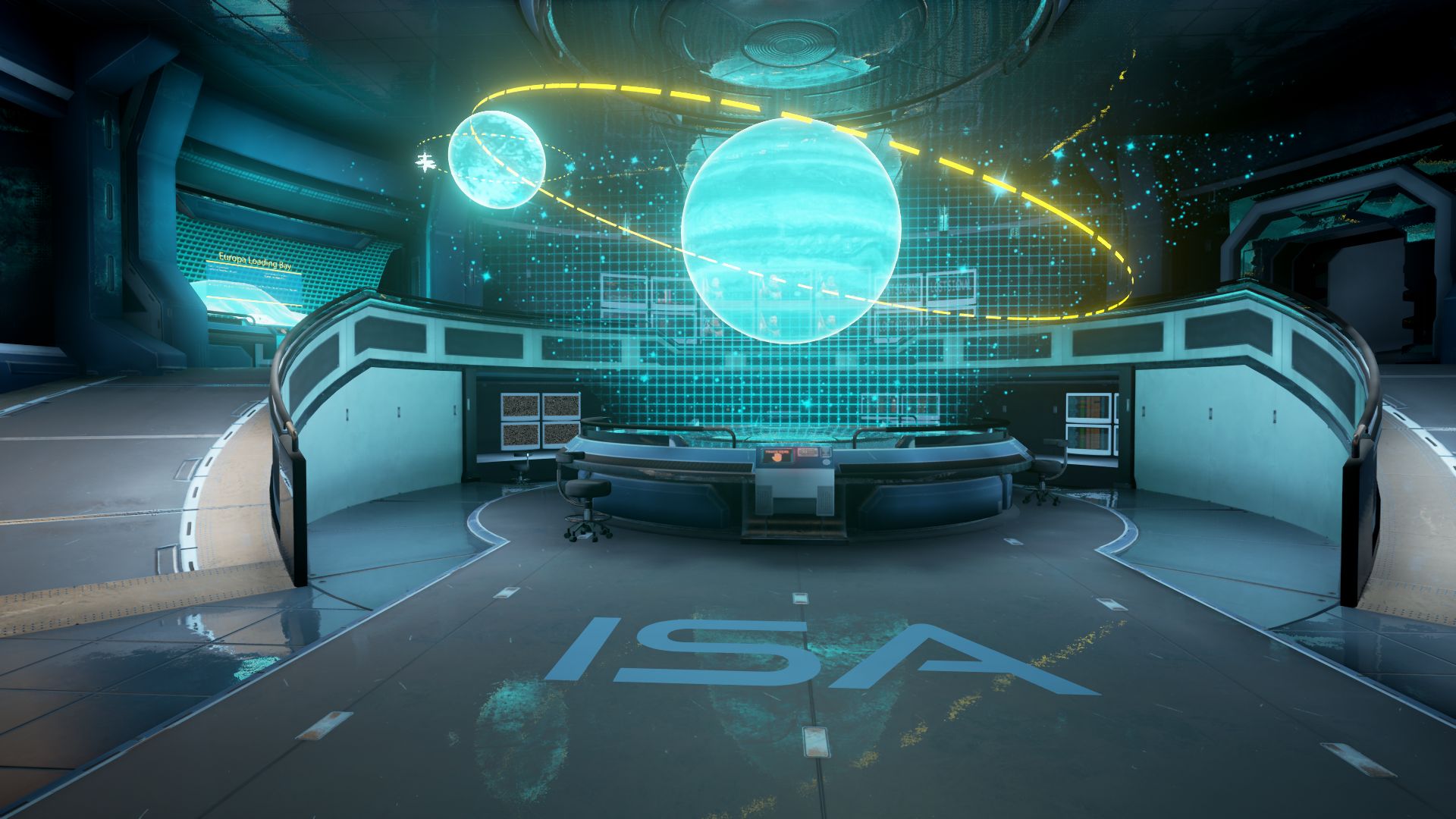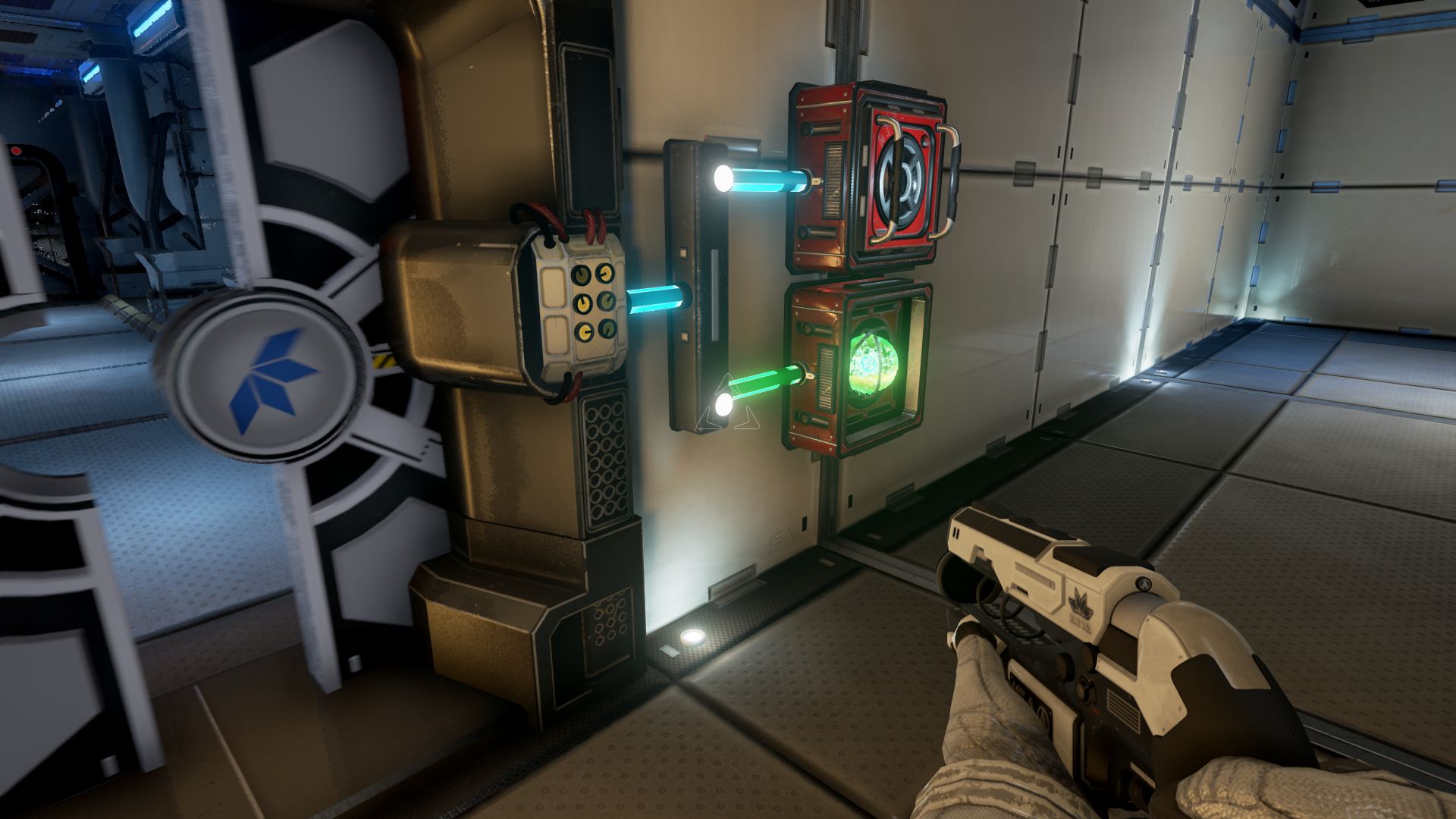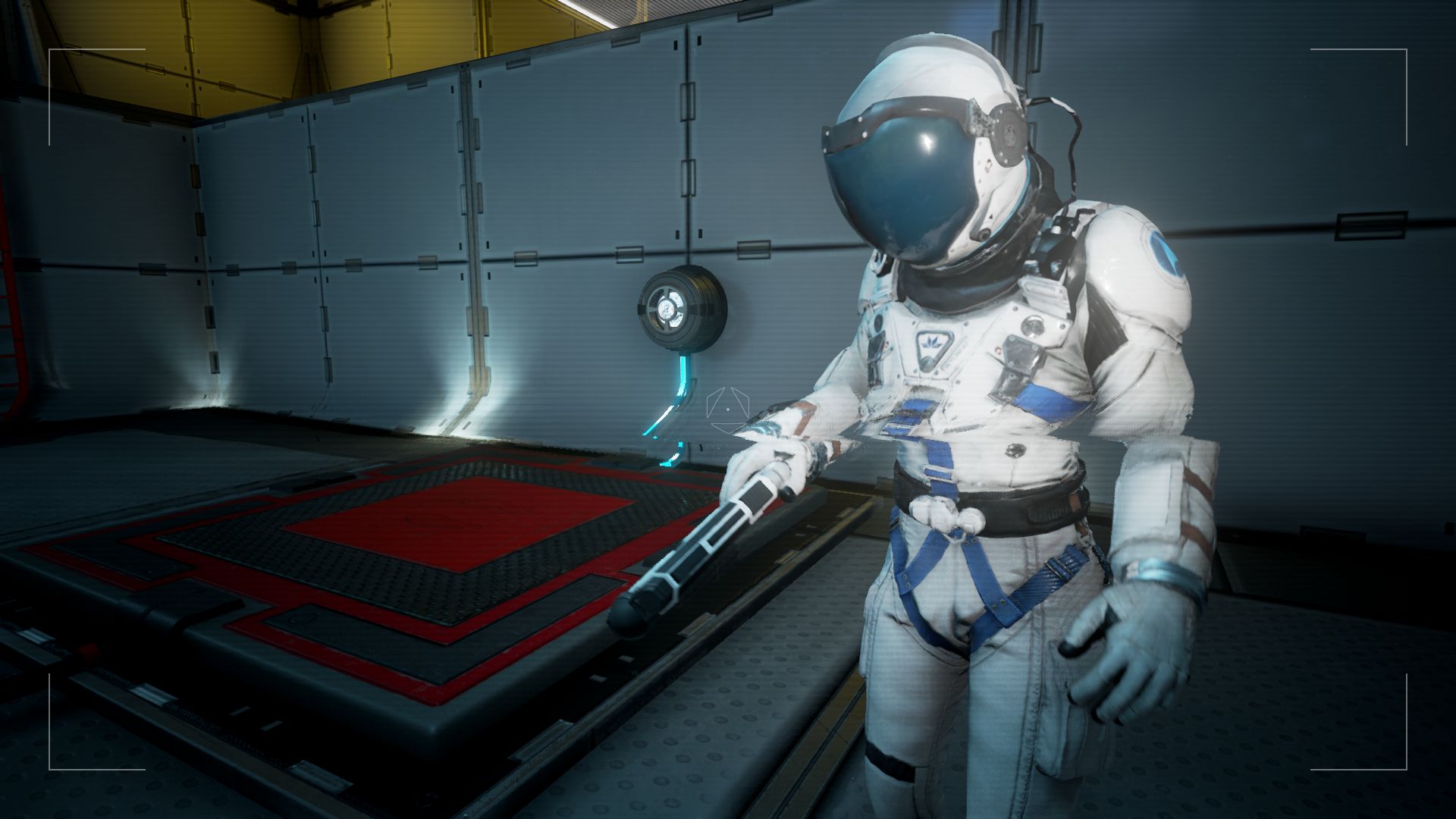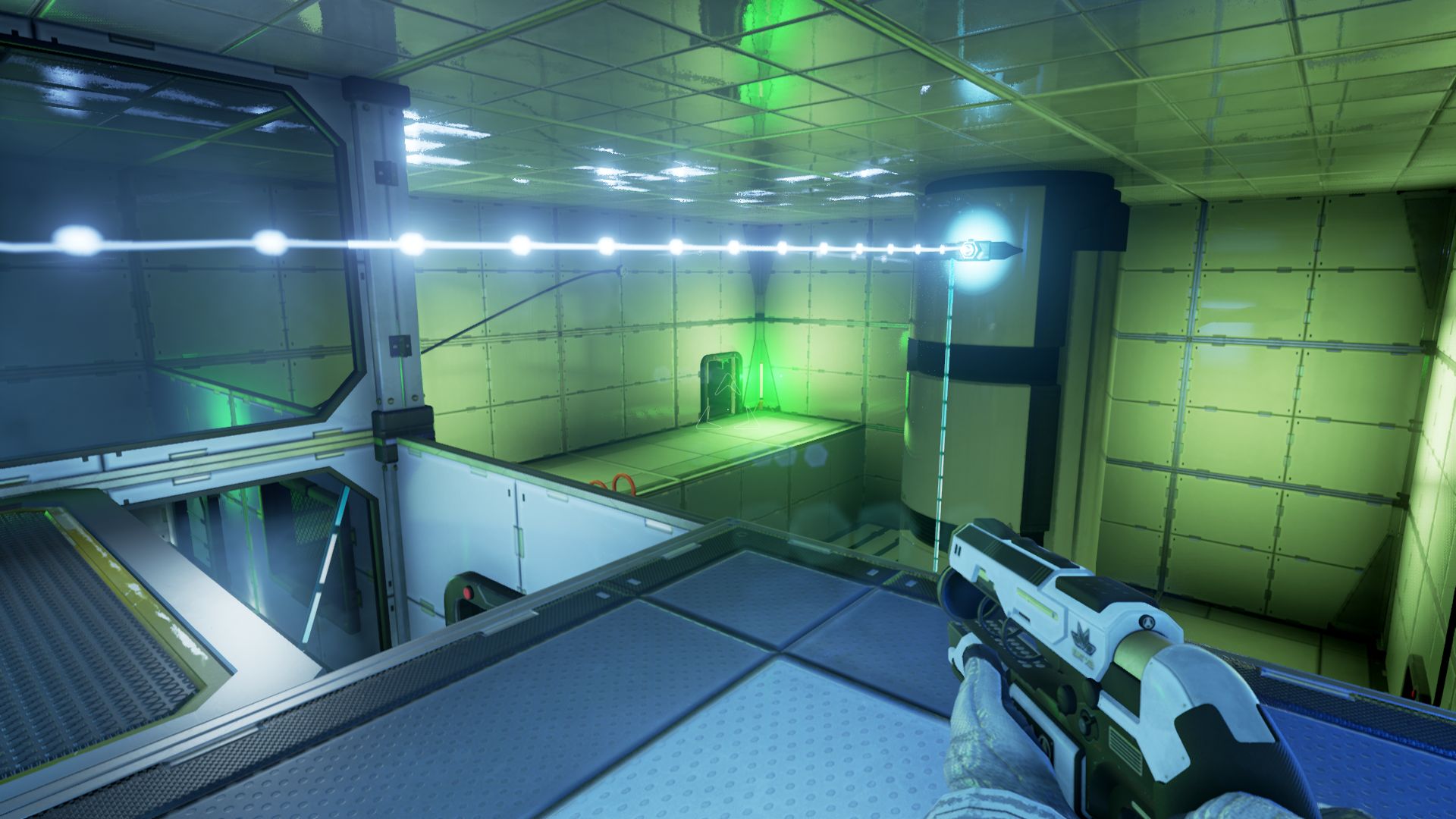The Turing Test Review
Take it one energy orb at a time
Portal has influenced many games since it released nine years ago. First-person puzzlers like QUBE, Quantum Conundrum, and The Talos Principle have shared many of its core traits. This emulation was applied down to the basics, with movable boxes, pressure switches, and lasers taking their place among the solutions. The Turing Test is another game with similar design characteristics, including a clean white-room aesthetic, an AI assistant, and a linear series of discrete puzzle rooms. Fortunately it also has a puzzle device involving energy orbs that dutifully keep the game from being a mere copycat.

All the puzzling in The Turing Test occurs inside a moon base on Europa—one of Jupiter’s moons—some 234 years into the future. An orbiting space station has lost contact with the ground crew and you must find out what happened. Your only contact is a computer AI called TOM (Technical Operations Machine) who provides information about prior events. After landing on Europa and entering the moon base, you will discover that the interior is little more than a series of test rooms. Someone, or something, has jumbled the modules and the only way to find out the truth is to get through them one at a time.
The AI assistant, TOM, will talk regularly about a variety of things including what happened to the crew and what it means to be human. Some of this occurs at the start of each puzzle room, just as you are trying to understand a new mechanic. If the game placed these voiceovers in the final stage of the preceding puzzle, they would have been easier to absorb. TOM does not have the humour of GLaDOS—or anyone else for that matter—and this can make his presence feel weak. Fortunately the events start to become interesting half-way through and TOM’s existence is justified.
The rest of the story is told through audio logs and emails from the missing ground crew. The audio logs could be interesting, but it sounds like they were recorded underwater while the voice actors played the harmonica. The excessive distortion and uneven volume make them near incomprehensible, and they don’t even have subtitles. Straining yourself to hear them is rarely worth the effort, so it is fortunate that they are short.
So the narrative is a bit rough, but The Turing Test is a puzzler and in this area it positively flourishes. The main puzzle device involves the Energy Manipulation Tool (EMT) which is basically a gun that can store and shoot energy orbs. These orbs are fired into nodes that are connected to doors, switches, and platforms etc. Thus, line of sight is crucial. There are also powered boxes that can be placed instead of the energy orbs, but nodes will need to be within arm’s reach. The objective is simple; use a limited number of orbs, and powered boxes, to get through each area. Using orbs efficiently requires thinking several steps ahead.

Use the EMT and energy orbs to get through each area
Although most orbs provide constant energy, some will pulse, powering devices intermittently; others will provide a brief activation before shutting down. When these differing orbs are present, their correct placement is pivotal. The short-lived orbs can open doors at the right moment and the intermittent orbs can raise platforms in synchronisation. Deploying the correct orb can be tedious if you collected them in the “wrong” order. Empty nodes are needed to reshuffle the orbs in the EMT and, while this does increase challenge, it adds unneeded busywork.
But it’s not all energy orbs and powered boxes; new mechanics are introduced steadily and usually require minimal explanation. Magnets can attract the powered boxes and drop them where required. Platforms can be moved, and there are even light-bridges that require power. Laser beams can be obstructed to disable or redirect power. Many of these devices are fairly standard for the genre and they work as expected. These additional mechanics are massaged into the puzzle rooms while still keeping the focus on shooting energy orbs.
The most refreshing change to the puzzles comes at the midpoint when cameras and robots can be commandeered inside the puzzle chambers. Cameras can be used to activate certain switches and robots can be steered through doors while your character stands on a pressure switch. This is similar to the co-op mode in Portal 2 although with one player. The puzzles gain a new perspective with this out of body experience and it greatly helps the back half remain as interesting as the first.

Puzzling so good, you will be beside yourself
Although the game is smart with brief 5-10 minute puzzle rooms, doing things incorrectly can get you permanently stuck. Resetting areas may be required after placing the wrong energy orb. While there are only a few situations where puzzle rooms can break entirely, players should still think of the consequences before flinging orbs around willy-nilly. The only erratic issue with puzzles involves pesky game physics; dropping boxes or using conveyers may require multiple attempts. Despite a few glitches, the difficulty curve is roughly linear with shorter tests interspersed to keep the experience skipping along.
All the test chambers are a good size with minimal wasted space. The generous lighting and high ceilings make the areas seem rather spacious despite their actual size. Inaccessible side rooms also reduce potential claustrophobia although they can be distracting at first. The only loading screens are found between chapters, so this means 10 puzzles can be completed in brisk succession to keep things flowing. Unreal Engine 4 is used efficiently with its trademark sci-fi sheen, despite the excessive lens flare.

The Turing Test is a suitably clever first-person puzzler with an interesting primary device. The energy orb gun is easy to understand and utilized well through its puzzle rooms. Puzzles require diverse solutions and getting through levels is somewhat like deciphering logic gates. Other devices come into play, including magnets and platforms, which are typical of the genre and interwoven logically. A major change at the half-way point gives the gameplay a fresh perspective. Even the story provides adequate breaks although its delivery could be better. Fortunately this puzzler shares the brevity of the Portal series, taking around six hours to complete with nary a misstep. The Turing Test may not hit as hard as Portal, but thanks to all the energy orbs it keeps the lights on, and shining bright.
 Comments
Comments












